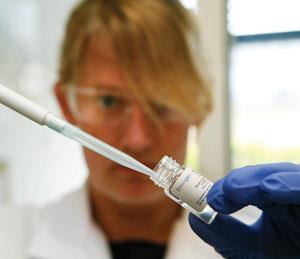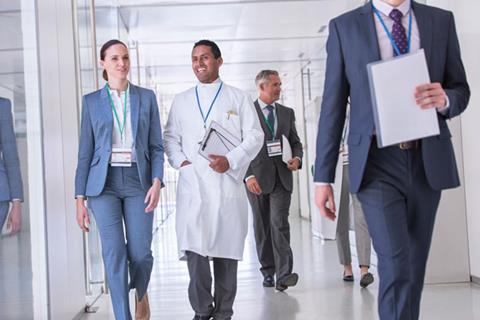Katrina Krämer examines efforts to bridge the gap between university research and commercial products
Every day sees the new research published by academics – the life sciences publishing database PubMed alone added more than 2 million articles to its collection between 2010 and 2014, the equivalent of one article per minute. But even the most promising discoveries may take decades to progress from the bench to real-life application. Crossing the ‘valley of death’, the phase between research and successful commercialisation, is not an easy feat. Innovation – the application of knowledge to develop new products, processes and services – is the key to economic growth, generating businesses, public services and ultimately jobs and wealth. Until the 1990s, universities played the role of basic science researchers in the innovation landscape; taking ideas to market – through design, engineering, manufacturing, marketing and sales – was the realm of companies. There were few touching points between these separate entities.
Things have changed, and the roles of universities and industries have changed too. Academic scientists are becoming more entrepreneurial, occupied with patents and spinning out companies based on their research, and industrial R&D departments are becoming more open to collaboration with academia for their mutual benefit. Many universities have opened technology transfer offices (TTOs) that support researchers building links to industry, patenting their findings or founding their own company. The University of Oxford’s Isis Innovation, an example of a particularly prolific TTO, has founded more than 100 spin-out companies since 2000.

Biogelx is such a spin-out company born from academic research at the University of Strathclyde, UK [see Refined gels for cultured cells]. Rein Ulijn, who moved to City University New York, US, in early 2014, is a co-founder of Biogelx and has been researching nanomaterials since 2003. About 10 years ago, his group serendipitously discovered that some short peptides could form gels at physiological conditions. ‘By talking to different people, including biologists, it occurred to me that these materials could be of interest for a number of applications,’ Ulijn says. Their chance discovery would eventually lead him to develop what many cell biologists were yearning for: a well-defined matrix for growing cells that mimics natural conditions – a much better growing environment than flat culture plates or petri dishes. Knowing that he might be on the way to a potential commercial product, but unsure about future development, Ulijn patented his findings.
Publish or patent
Researchers often overlook, misunderstand or undervalue the importance of patents, says Mike Arnott, physical sciences investment manager at Cambridge Enterprise, the University of Cambridge’s TTO. ‘Some think that if something was [not patented and therefore] free to develop, everybody would develop it in a good, beneficial way.’ But this is not always the case – some scientists have found their research used by others to make low quality, even dangerously defective products. Without a patent, the original developers are left without legal means to stop the producers. Arnott adds that the fundamental contradiction researchers face – demands to publish, to ‘get their research out there’, versus commercialising, which restricts publishing to patenting timelines or even trade secrets – has not been sufficiently addressed so far.
After their initial patent, Ulijn and his group spent many years developing their idea further in their labs, but with a view on commercialisation. ‘The option to commercialise the product actually changed the direction of our research and the way we did our science,’ Ulijn remembers. Eventually things started to fall into place. ‘The University of Strathclyde’s TTO paired me up with a business mentor, who is now the chief executive of Biogelx. Meeting with him we eventually decided to go all the way and launch our spin-out company.’
Despite their progress, Ulijn’s team still had, as he says, a very academic project in their hands. ‘It worked well with individual researchers in our lab but as soon as someone new joined the project, it required some training and fiddling to get it to work in the exact same way,’ Ulijn laughs. Turning their research into a commercial product – something that works every time and can be used by a large number of people – is what the company was occupied with in its early stages. ‘It is not something you’d do in an academic lab, it’s not something we’re good at,’ Ulijn says, ‘but it’s the company that made it possible.’
A nose for the market
Having created consistent-quality and user-friendly initial products, spin-out companies need to develop a strong market sense – a ‘nose’ for future developments in their area – to grow and survive in the long term. ‘There’s always the uncertainty of not knowing what the market is going to be like in five or 10 years’ time for whatever you’re producing,’ says Arnott. ‘This poses an additional difficulty when trying to raise sufficient funding for commercialisation.’
TTOs help researchers decide on the commercialisation route – not every idea can lead to a spin-out company. Sometimes licensing intellectual property (IP) to an existing company that is prepared to bring the technology to the market is the smarter option. ‘It is important not to be prescriptive,’ warns Arnott. One of the difficulties TTOs are facing is the range of research they have to deal with, not all of which they can have expert knowledge of. To support researchers with facts and figures about products and markets, a TTO’s network of experts is one of their most valuable resources. ‘What we do is find the best person in our existing network to help us get an idea of who the right people to talk to are and how a particular segment works,’ Arnott explains. However, he says, smaller TTOs often don’t have the funds to pinpoint a piece of technology to the right industry segment.
‘A good TTO is absolutely critical,’ Ulijn agrees, while recognising the fact that not every university can provide a TTO, meaning support remains patchy and location-dependent. ‘I’m certainly very much an academic,’ he admits. ‘I like the entrepreneurial side of things but I have no interest in being a business person. Academics are encouraged to be more entrepreneurial – but then again, we’re encouraged to do more of a lot of things.’
‘It is almost impossible to maintain a world-leading academic position and join a start-up as well,’ agrees Arnott. TTOs, he says, can offer significant support to get an invention to market while shielding researchers from the demands of commercialisation.

Eleanore Irvine, now production development manager at Biogelx, first heard about Ulijn’s spin-out plans while she was a PhD student in his collaborator’s group at the University of Strathclyde. ‘Eleanore came aboard to really bridge the academic and entrepreneurial side and the university has been very helpful in making this possible,’ Ulijn explains. Irvine had been interested in commercialisation during her PhD studies and, despite having no formal business training, took on a lead role in Biogelx’s product development, funded by a Royal Society of Edinburgh enterprise fellowship. ‘The fellowship offers training to people coming out of a PhD, postdoc or lectureship to support and guide them in the commercialisation of research, with a view to creating a spin out company,’ Irvine?explains.
Biogelx has now moved on from testing their gels through collaborations with their cell biology research partners to commercial sales and is expanding its product range. Ulijn and his group provide the company with a pipeline of ideas. ‘We’re in a unique position having academic IP backing us up, which is both good for them and for our company,’ says Irvine. ‘Ulijn and his team know that their IP is in good hands and that it will be used to develop innovative and commercial technologies. For Biogelx, Ulijn’s group provides a great idea pool for a pipeline of new products.’
Spin-out opponents
There are people who argue against universities increasing their entrepreneurial aspirations. Paul Nightingale, deputy director of science and technology policy research at the University of Sussex, UK, says that the focus on founding spin-out companies – a ‘science park economy’ – misinterprets the role of universities in technical innovation.
He claims that universities should act as providers of talent rather than commercialisation hubs. Academic research, Nightingale says, produces three things in order of decreasing importance: talented people who then go on to work in industry, high quality new technology and spin-out companies. The latter, he claims, is normally more effort that it’s worth. Small companies have low survival rates, Nightingale argues: they usually disappear within only three to five years of being founded. ‘The data clearly says that large firms are where the action is, or increasingly large firms engaging in innovation processes in collaboration with networks of small firms,’ he says.
Strong links between established companies and academia is what is needed to achieve economic growth, explains Nightingale. ‘Academics should focus on doing the research and then pass it on as quickly, easily and unbureaucratically as possible to established firms, which then commercialise it. Universities aren’t, and shouldn’t be, the main source of?innovation.’
Fostering relationships
Many chemical and pharmaceutical companies have already realised the potential benefits of working with academia. ‘The old model of the monolithic company that does and controls everything behind its firewall is now outdated. Lots of different companies are trying to explore other options,’ says David Andrews, associate director of oncology chemistry R&D at AstraZeneca and industry associate for open innovation at the Royal Society of Chemistry.
Open innovation blurs the boundaries between companies doing their own R&D and buying in external ideas and technologies. Working in partnerships during the innovation process means risks as well as successes are shared. In the last five years, most large chemical and pharmaceutical companies have added open innovation to their strategy.
GlaxoSmithKline (GSK), for example, posts a list of ‘wants’ on its website. Visitors to the site are encouraged to get in contact if they have an innovative technology or idea that matches one of these wants, with the idea being that GSK will work with them through the product development process. The company currently has over 50 wants listed online, including ways to produce enjoyable heartburn relief medications with customisable flavours and new oral care devices that go beyond tooth brushing.
The BASF website also encourages potential open innovation partners to get in contact. ‘[Collaborations] enable us to gain access to new technologies and new areas of business, and also provide BASF with access to young talent in many different regions of the world,’ explains Valérie André, BASF’s open innovation lead. She coordinates the company’s collaborations with academic research groups. ‘In return, we offer scientists the opportunity to cooperate in close-to-practice research projects and to thereby create added value for society by developing innovative solutions.’ Their academic partnership programme establishes not only one-off, project dependent collaborations but aims for longer lasting partnerships.

While BASF keeps scale-ups and process development within their own R&D department, early-stage and experimental projects – on topics including graphene and new catalysts – that require more basic research often involve specialised academic collaborators. ‘The most important challenges are managing expectations on both sides and developing a clear mutual understanding of the research goals and objectives,’ explains André. ‘We count on a close relationship and a regular scientific exchange to facilitate the understanding of our company culture.’ To nurture a mutually beneficial relationship, their contracts always try to satisfy both sides’ expectations. They allow researchers to publish research papers of their collaborative work, explains André, while at the same time securing company IP.
Programmes set up to facilitate information exchange between academic and industrial research institutions are one way to kick-start the creation of successful collaborations such as those at BASF. The National Compound Collection (NCC) is an example of a UK-based scheme being piloted to aid academic knowledge transfer. The idea is to systematically extract compound data from synthetic chemistry PhD theses and deposit them in a virtual library for industry to view. The French equivalent, the Chimiothèque Nationale, operational since 2003, has accumulated over 57,000 physical compound samples, accessible through an online database. The NCC has, in a trial run collaborating with the University of Bristol, unearthed over 37,000 structures of interest to the pharmaceutical and agrichemical industry.
‘After this pilot, the challenge for the chemical community is to ask: where does this project go next, how does it get scaled and how can it be made self-sustaining?’ explains Andrews. To answer these questions, his team is talking to both industry and academia. The project needs to benefit both sides and be economically viable to become part of the innovation process, says Andrews. If the NCC was able to provide actual physical samples rather than just structures (like the French version), it would certainly improve the chances of the compounds becoming commercialised.
The valley of death, which 30 years ago was a sparsely populated inhospitable place, is becoming ever more accessible for academic researchers. It is blossoming into a vibrant landscape dotted with technology transfer offices, university spin-out companies and academia–industry collaborations.













No comments yet